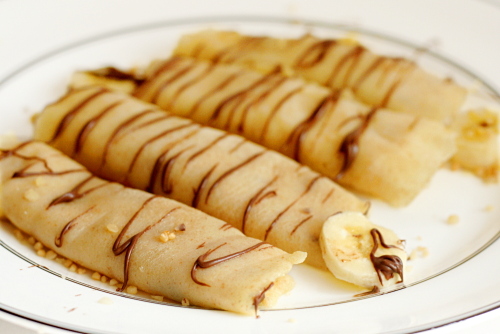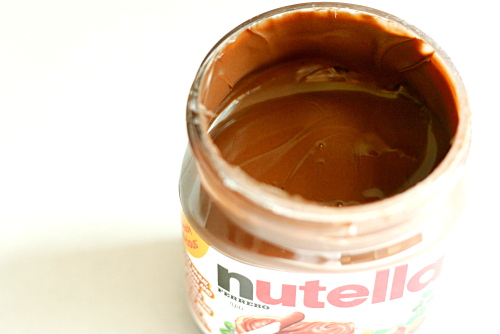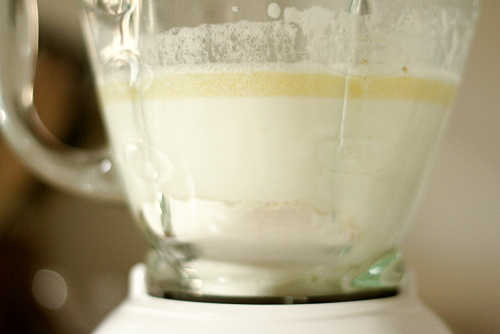
I ate Nutella, a chocolate hazelnut spread, for the first time just about a month ago. I’d been hearing great things about it for years, but I never got around to trying it until a friend sent me some. (Along with a jar of Marmite, which is so good.) I can see what all the hype about Nutella is for – this stuff basically tastes like milk chocolate, so of course everyone likes it!

I’ve been putting it on all kinds of things, but mostly I eat it on bananas to break up the monotony of my daily banana. And how much better would bananas and Nutella be if they were wrapped up in a crepe?
Crepes are one of those recipes that seem scarier than they really are. I’m always hearing stories about how the first crepe will have to be thrown out, and they’re so delicate, and all these things, but I’ve never had any problems cooking crepes. Maybe that means I’m doing something wrong, like making them too thick, but since I’m happy with the way they turn out, I see no reason to change anything.

I used Jess’s crepe recipe, as she describes her family as quite the experts in crepe-making. But, I didn’t trust the 100% whole wheat flour idea, so I used half white and half whole wheat. I also had to make them tiny, because I was between medium-sized nonstick pans at the time.

This seems like a great crepe recipe! The bananas and Nutella were really good, and I sprinkled over some hazelnut praline I had leftover from the filbert cake. I’m eager to see what else I can come up with to put in crepes. Sweet variations are almost too easy, and I know sausage and maple syrup are delicious in crepes. What about savory options? I need to do some exploring.

Whole Wheat Crepes (adapted from hogwash)
Jess implores her readers to eat the crepes as soon as they come out of the pan, but I didn’t. I stored them in a 200 degree oven until they were all cooked, so that Dave and I could eat together.
6 servings
2 cups milk (plus more, if needed)
2 large eggs
8 tablespoons unsalted butter, melted, plus more for the pan
1½ tablespoons sugar
½ teaspoon salt
1⅔ cups (8⅓ ounces) whole wheat flour (or a mix of white and whole wheat)
6 bananas, sliced
6 tablespoons Nutella
1. Combine the milk, eggs, melted butter, sugar, salt and 1 cup flour in a blender, and whirl until smooth, scraping down the sides of the glass, if necessary. Add all or most of the remaining flour, a bit at a time, until the batter has roughly the consistency of drinkable yogurt (very thin for pancake batter, but not runny). Let the batter sit at least 30 minutes at room temperature, or overnight in the refrigerator. (Bring the batter back to room temperature before continuing.)
2. Before cooking, thin the batter with a bit more milk, if it seems substantially thicker.
3. Preheat a crepe pan or large nonstick skillet over medium-high heat. When hot, grease with a dollop of butter (using a stick of butter to smear some directly on the skillet works nicely), and add enough batter to coat the skillet in a thin, even layer when you swivel the skillet around in your hand. Cook for a couple minutes, until you see bubbles in the center of the crepe and the bottom side is nicely browned. Flip carefully and cook another couple minutes on the other side. Fill as desired (in this case, with the sliced bananas and Nutella) and serve immediately. Repeat with the remaining batter.






















































